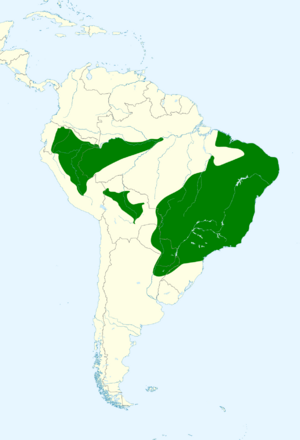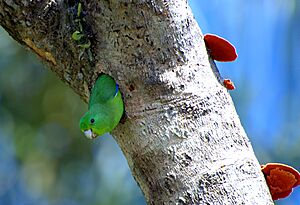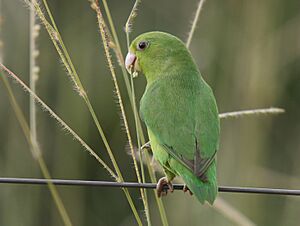Cobalt-rumped parrotlet facts for kids
Quick facts for kids Cobalt-rumped parrotlet |
|
|---|---|
 |
|
| Male in Goias, Brazil | |
| Conservation status | |
| Scientific classification | |
| Genus: |
Forpus
|
| Species: |
xanthopterygius
|
| Subspecies | |
|
|
 |
|
The cobalt-rumped parrotlet (Forpus xanthopterygius) is a small, colorful parrot. It is also known as the blue-winged parrotlet. These birds belong to the parrot family, Psittacidae.
There are two main types, or subspecies, of this parrotlet. They are called Salvadori's cobalt-rumped parrotlet (F. x. flavescens) and Hellmayr's cobalt-rumped parrotlet (F. x. flavissimus).
Contents
About the Cobalt-Rumped Parrotlet
What Do They Look Like?
The main type of cobalt-rumped parrotlet (Forpus xanthopterygius xanthopterygius) is usually about 12 centimetres (4.7 in) long. They weigh around 28 grams (0.99 oz), which is about the same as a few coins. These parrotlets are mostly green or olive green. They have light peach-colored beaks and feet, and dark brown eyes.
Male and female parrotlets look a bit different. This is called sexual dimorphism. Males have bright purple-blue feathers on their wings and a bright blue patch on their lower back, called the rump. Females do not have these blue markings. Instead, their foreheads are yellow-green.
Like all parrots, these birds have special feet. Two of their toes point forward, and two point backward. This is called zygodactyly, and it helps them grip branches and food. Young parrotlets look like the adults. However, young males might have some green feathers mixed in with their blue markings.
Different Subspecies
- Salvadori's cobalt-rumped parrotlet (F. x. flavescens): These parrotlets are more yellow-green or paler than the main type. Males have lighter blue markings on their wings. Their foreheads, cheeks, and undersides are also more yellow-green.
- Hellmayr's cobalt-rumped parrotlet (F. x. flavissimus): Both males and females of this type are more yellow-green or paler. Males have more yellow-green on their foreheads, cheeks, and throats.
Where Do They Live?

Cobalt-rumped parrotlets live in many parts of central and northern South America. Each subspecies lives in a slightly different area. They are quite common in general, but you might find fewer of them in the Amazon Basin.
These parrotlets mostly live in lowland areas. They like dry and riparian woodlands, which are forests near rivers. You can also find them in places like cerrado (a type of savanna), caatinga (a dry shrubland), palm groves, and savannas. They tend to stay away from very thick forests. You won't find them living higher than about 1,200 metres (3,900 ft) above sea level.
Most cobalt-rumped parrotlets do not migrate, meaning they stay in the same area all year. However, some groups in Argentina move around locally. They follow the flowering seasons of plants they like to eat. Parrotlets in the Brazilian Atlantic Forest move to different altitudes depending on the season. This is called altitudinal migration.
How Are They Doing?
The exact number of cobalt-rumped parrotlets is not known. However, their population seems to be stable. Because of this, the IUCN Red List lists them as a Least Concern species. This means they are not currently at high risk of disappearing.
Threats to Parrotlets
Unlike some of their relatives, cobalt-rumped parrotlets do not seem to be greatly affected by deforestation (when forests are cut down). They also don't seem to be harmed much by the pet trade. Many areas where they live are already protected, which helps keep them safe.
Parrotlet Behavior
Social Life
These parrotlets are very social birds. They often gather in groups, or flocks. A typical flock has about 20 birds. But if there's a lot of food, like fruiting trees, a flock can grow to more than 50 birds! They usually feed in smaller groups of 2 to 12 individuals.
Cobalt-rumped parrotlets make different sounds. When they fly or sit on a branch, they make high-pitched "sheet" or "zeet" screeches. When they are eating or socializing in big groups, they make chattering and twittering noises.
Raising a Family
The breeding season for cobalt-rumped parrotlets is usually from May to August. However, nests with eggs have been seen in other months too, depending on the area. Females lay 3 to 7 small, white, round eggs.
Sometimes, these parrotlets have been seen scraping the clay nests of another bird called the rufous hornero. Scientists think they might be "taste-testing" the clay to see if it's good for their own nests. Rufous hornero nests have been used by parrotlets to raise their young. Other studies suggest that eating clay might give the parrotlets important minerals they need.
What Do They Eat?
Cobalt-rumped parrotlets mainly eat fruits from Cecropia sp. and Ficus sp. trees. They also enjoy seeds from Mikania sp. and Trema micrantha plants. Their diet also includes flowers from plants like Ambrosia sp., Handroanthus serratifolius, and Marcgravia sp.. Sometimes, they will also eat grass. As mentioned before, they might move to different areas based on when their favorite plants are flowering or fruiting.
Naming and History
For a long time, the cobalt-rumped parrotlet was thought to be the same species as the green-rumped parrotlet. But now, most experts agree they are different species. Other parrotlets, like the turquoise-winged parrotlet and the riparian parrotlet, were also once thought to be the same as the cobalt-rumped parrotlet. However, studies in 2015 showed they were different based on how they looked and where they lived. Some groups, like the American Ornithological Society, still consider them the same.
The name of the cobalt-rumped parrotlet has changed a few times over the years. The scientific name F. xanthopterygius originally referred to two different birds! In 2021, the common name of the species was officially changed from "blue-winged parrotlet" to "cobalt-rumped parrotlet" by the IOC.




